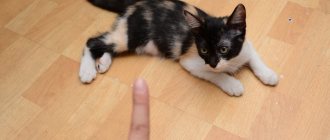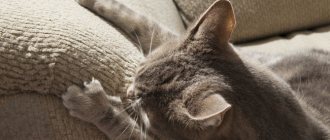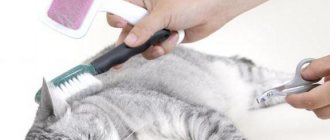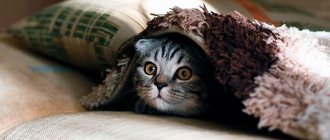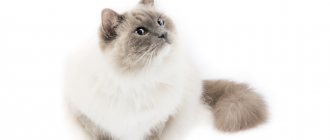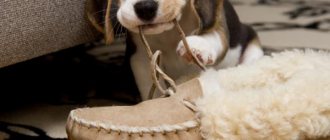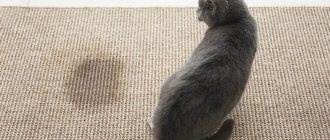Cats are very clean by nature and in addition to basic hygiene procedures, they also often sharpen growing claws, choosing different surfaces in the house for manicure activities. Most often, upholstered furniture suffers from scratching with sharp claws, which the owners of a furry friend really don’t like. If you already have a question on your mind: how to stop a cat from tearing up furniture, our article will be interesting and informative for you!
Today we will look at some methods and recommendations from experts that will help you find the answer to the question - how to stop a domestic cat from sharpening its claws on the sofa and other surfaces in the house. Advice from experienced experts will help maintain the integrity of furniture and walls in the interior, without losing friendly relations with the pet itself!
Why do cats do this?
Before answering the question - how to stop a cat from scratching the sofa, let's look at the most likely reasons for this behavior. So, why are domestic felines so fond of sharpening their claws on soft furniture:
- The most common reason is physiological, which involves the need to sharpen the claws against the background of itching in the pads of the paws. This is due to the natural replacement of old claws with a keratinized layer with new, sharper and younger ones. During this process, hangnails may appear on the paws, causing unpleasant discomfort to the animal. To get rid of these painful signs and speed up the process of growing new claws, the cat grinds them using suitable surfaces, which are often furniture facades, walls and even a soft-pile carpet.
- The fight for territory is another reason why cats have the desire to sharpen their claws on furniture. There are sweat glands on the paw pads, which, when in contact with a soft surface, leave a characteristic animal odor. In this way, the cat marks its territory in the house.
- In the process of sharpening your pet's claws, all muscles and tendons are used, which allows you to maintain physical fitness. This procedure can be compared to good sports exercises.
- Cats are very susceptible to stressful situations. They may worry for a long time about separation from a loved one, worry about moving to another house, and even bring themselves to panic if the owner does not pay attention to her for a long time when returning home after work. Scratching walls and furniture is a great way to relieve nervous tension, get rid of stress, and at the same time attract the owner’s attention to your person.
If you are still looking for an effective way to stop a cat from scratching the sofa, think, maybe the reason for this behavior has a lot to do with your indifference towards your tailed friend? Showing care and love can significantly change the behavior and habits of your pet.
Stopping unwanted behavior
Scare away with loud sounds
This remedy can be effective on cats that are very timid by nature. At the moment when the pet approaches the crime scene, you can loudly and sharply shout “No!”, “You can’t!”, “Scram!”, make a sharp noise with something (a container with coins or stones), and clap your hands. A timid furry friend will jump to the side. It is advisable to then take the pet in your arms, relieving slight fear, and sit it next to the scratching post.
Sharpening her claws is an instinctive behavior, so there is no point in scolding her. It is also not advisable to scold her near the scratching post or when she sharpens her claws on it. It should evoke only positive emotions in the animal.
Inflated balloons attached nearby will perfectly scare a cat away from the furniture, which it will definitely touch during sharpening. The animal will experience unpleasant sensations from a bursting balloon. This will scare the pet away and make you think next time whether it’s worth approaching.
Repelling with liquids
Everyone knows that cats for the most part are not fans of water and everything connected with it. Find or purchase a spray bottle, fill it with water and place it near the place where the furniture was damaged. Every time your pet walks past furniture or gets ready to sharpen its claws, spray it with water. It is advisable to spray before the start of the procedure so that she develops unpleasant sensations associated with this place and the planned actions. If you spray her after the deed, she will most likely not understand the reasons for attacking her. This product is harmless to cats.
Try to spray so that water does not get into the animal's ears. Otherwise, water that gets into the ear can cause inflammation of the ear organs - otitis media.
You can add tangerine, orange or lemon oil to the spray bottle. Their smell is the most unloved for furry friends. Spray the furniture with it and use it every time your pet tries to tear up the furniture. The advantage of this product will be not only the animal being scared away from the furniture, but also the apartment being filled with a fragrant smell.
Clue! Remember to shake the spray bottle before use, as oil and water tend to separate.
At a pet store you can purchase a device with a motion sensor with a built-in gas cartridge. It should be installed near the place of regular damage, pointing directly at it. As soon as the animal approaches it, the device will work and spray with a repellent. An ideal remedy for teaching a cat not to tear up furniture in the absence of its owners. The downside is that it’s not a cheap pleasure.
You can also separately purchase a product in pet stores in the form of a spray that helps prevent your cat from tearing up furniture. True, many owners note that they are ineffective.
Alternative option! You can place the dried zest of any citrus in cotton bags and place it near the spoilage area. Various strong-smelling spices (ground chili pepper, suneli hops, coriander) are also good deterrents, which can also be placed in bags in crime areas.
Distracting
Often it is enough to simply distract the animal’s attention from its favorite furniture. You can throw a toy, give a treat, pet it. Pets usually like all this, so they can easily distract attention.
You can also distract attention with a board that will imitate your favorite walls, if you stick the same wallpaper on it and put it in the same place, covering the real one. There is a high probability that the animal will sharpen its claws on it. After some time, you can gradually begin to move this board to a place where it will not be an eyesore. The animal will move with it. The main thing is not to rush in this matter.
What kind of coverings is a cat indifferent to?
The cat chooses hard surfaces of furniture items for sharpening its claws for a reason. In the natural environment, they often scratch the bark of trees, but at home they find a completely alternative solution in the form of interior furniture.
In addition to wooden facades, they are attracted by the soft upholstery of sofas and armchairs. Thick curtains, walls with wallpaper and carpets are also quite suitable for sharpening claws.
If you have started renovations in a house where a cat lives, you can pre-select materials for interior decoration that are unsuitable for sharpening claws.
Which surfaces are not interesting for furry friends:
- fiberglass wallpaper;
- ceramic wall tiles;
- fake diamond;
- decorative plaster;
- plastic panels;
- high strength laminate;
- smooth linoleum;
- PVC floor tiles.
Limiting opportunities to sharpen claws
Trimming the claws
Since cats need their claws sharpened, we should help them. First, go to the veterinarian so that he can explain how to do this correctly, otherwise you can hurt your pet and damage a blood vessel.
The pet may resist, but you should continue until the pet gets used to it. It is better to teach from an early age. Praise your fidget every time so that he feels your care.
Trimming their claws is useful especially for those cats that do not go outside.
Nails must be trimmed using special nail clippers (nail clippers for dogs are prohibited).
We put attachments on the claws
Thanks to these attachments, the cat cannot scratch anything at all, since they cover the sharp part of the claw. You can glue them yourself with special glue, without the help of a veterinarian. Such attachments do not restrict reflex movements and allow you to calmly extend and retract your claws. They last for about 3-6 weeks, after which it is worth repeating the gluing procedure.
But this method is characterized by high cost and troublesome maintenance, since after removing the attachments, you need to file down the overgrown claws in order to put on new attachments.
For adult cats, this method is very painful, because, having become accustomed to a certain way of life, it is difficult for them to realize that now they cannot do something. At first, owners have to follow their pet around the apartment to prevent injuries to the animal, which, as always, decides to jump on the wall or somewhere else.
We remove claws if we find advantages in this
Since this is a surgical intervention, it is worth considering all the pros and cons, and also consider the risks:
- During this procedure, not only the claws are removed, but also the phalanges of the fingers. A number of cats undergo this operation without complications, but there are some that develop chronic pain and arthritis after the operation.
- Without claws, a cat becomes more vulnerable. Coordination of movements is impaired. She will no longer be able to defend herself the way she used to. She will no longer be able to climb trees. And if he tries to jump onto a tree, he will easily fall off it and may get hurt.
- It is very important to study the documents when purchasing an animal. Sometimes they indicate that declawing cannot be done.
- Be sure to consult your veterinarian before the procedure.
Think about it, if you want to condemn your pet to such torment, then maybe you shouldn’t have one at all.
We use a spray bottle
If your cat has learned to perform manicure procedures using upholstered furniture, experts recommend teaching the cat a lesson using a spray bottle of clean water. As you know, representatives of the feline family fear water procedures, so a stream of refreshing water will quickly discourage the desire to scratch the furniture in the house.
Advantages of the method:
- works effectively after several water procedures;
- does not require additional costs, clean water is always available to people.
Flaw:
- the method works only during the period of time spent together in the room;
- being unattended by the owner, the cat will happily continue the work it has begun.
How to avoid mistakes
Many people, when they get a small kitten, perceive it as a living toy, imagining that keeping it will not cause any problems. But when the baby begins to misbehave: he spoils the wallpaper with his claws or “combs” the upholstered furniture, they begin to punish the fluffy, who, oddly enough, becomes more and more naughty day by day and causes more and more damage to the environment.
If your cat has already chosen a piece of furniture or a piece of wall for a claw point, you need to protect this place.
If someone has this exact perception of a cat, it is better not to get one at all. The handsome tailed cat needs to be educated from the first days of his life, and if the time for education is lost, then he needs to be re-educated. To do this, be patient, don’t get angry and don’t punish the baby.
A cat pulls wallpaper much more often if its claws are long enough and it catches on everything.
In order not to raise a small cat into a big egoist and not turn into his slave, it is worth familiarizing yourself with the methods of proper handling of cats. The owner must help the baby learn order, calmly and purposefully.
In nature, cats sharpen their claws on a tree trunk, thus marking their territory.
In addition, it is worth familiarizing yourself with the experience of other owners who highlight the most significant mistakes in raising four-legged animals and not repeating them:
- You cannot punish an animal;
- You should stop trimming your nails yourself and contact a veterinarian for help;
- It is better to keep the old scratching post - the animal may not like the new one, but it is better to place it at the front door or near the bed;
- If the scratching post still needs to be replaced, then objects should be placed next to it that will distract the fluffy’s attention from his destructive actions.
Cats often damage furniture in the house.
We use strong odors
If your cat is accustomed to bath procedures from an early age and does not react at all with fear to a stream of cold water, the question of how to wean a cat from sharpening its claws on a soft sofa remains open.
In this case, we recommend trying the scent repellent method. Cats cannot tolerate citrus scents. To quickly wean an animal, it is enough to place the peel of a fresh orange or lemon in the place where the cat often sharpens its claws.
You can also use essential oils with a citrus aroma and freshly squeezed juice of these fruits. However, we do not recommend treating woven surfaces with such means, since after weaning the cat you will have to look for ways to remove greasy oil stains on the beautiful fabric of the sofa and armchairs.
Advantages:
- 100% result.
Flaw:
- you will have to stock up on citrus fruits to organize effectively working “traps”.
What other smells does a cat not like: coriander, chili pepper and other aromatic spices.
Owner reviews
Many cats do not like small scratching posts - it should be 65 - 70 centimeters high - otherwise the cat will not be able to stand on its hind legs and stretch out. When caught in the act of a crime, you take him to the scratching post and scratch it with his paws. Treat the scratching post with catnip - and show it to the cat - many people react well to mint... Many people love corner scratching posts... When you leave, you can put a cover made of polyethylene film on the sofa... Or, leaving the cat alone, close the room - his bed is in the corridor, let him go to the kitchen to eat, to the toilet and that’s it...
OAya
https://www.u-mama.ru/forum/family/pets/714922/index.html#mid_23985664
To get started, buy either a special training spray or catnip. smear/spray the scratching post, the cat should be interested. Next, every time the cat sharpens its claws in the wrong place, you punish it (you can spray it with a spray bottle), and if it’s in the right place, then praise it very, very much, give it patience and time.
Nuiladna
https://www.e1.ru/talk/forum/read.php?f=74&i=413805&t=413805&
Try putting her “awake” on the scratching post, usually the kittens begin to stretch and sharpen their claws, I taught mine that way. And simply bringing it to the scratching post several times a day and putting its paws on it is usually understood. You can try to lure it with a teasing toy, move it up and down - the kitten starts jumping up on its own. Immediately stroke and praise the child... Mine, after a week, realized that the scratching post is nicer, and “mom” does not swear, but praises... Also, pay attention to where the scratching posts are and where the kitten likes to sharpen his claws - maybe move it to that place ?
Ksana
https://mauforum.ru/viewtopic.php?p=15273
Firstly, the scratching post really needs to be placed where your pet is used to sharpening its claws. They come already impregnated with a special composition that attracts cats. Even if the cat does not want to use the scratching post at first, over time it will begin to get used to it. There is also this trick: veterinary stores sell a special herb called catnip. Cats love her very much. It usually comes in dry form and is sold in a bag. You can hang this bag next to the scratching post, it will attract the cat with its aroma, or you can simply rub this mint on the scratching post itself. Try it, it gives results. In addition, scratching posts come in the form of a ball - a toy. A ball wrapped in these same ropes for sharpening claws. A very cool toy. The cat plays with him, jumps on him, grabs him with his paws and at the same time sharpens his claws. So there are many options for weaning your cat from sharpening its claws on furniture.
Valentina Bragarnik
https://forum.koschki.ru/index.php/topic/34-kak-priuchit-vzrosluiu-koshku-k-kogtetochke/
You can also try different options for the position of the scratching post (including different scratching posts - if you can’t try one) - vertical, inclined, horizontal. Cats have different preferences. My tail sharpens its claws exclusively on the vertical scratching post, and the horizontal one is lying around unattended.
Robust
https://forum.mau.ru/viewtopic.php?t=60099
And also, as it turned out, it is important not only what it is made of, but also WHERE it is located!!! According to my observations, cats prefer soft fabrics, cats prefer tougher ones, and the last Cat “clawed” an unpainted linden baseboard into two parts in 4 years - I’m honestly not kidding! Now Kosha and I have two scratching posts in the house: - a corner one, attached to the corner in the corridor, in the “slip point”... when Kosha has “Tygydym games”, running from the kitchen to the room, she no longer skids as before, but bounces off vertically attached corner scratching post... -and the second one lies on the floor in front of his favorite chair...so “on the way to the bedchamber” and barely waking up, Kosha stretches and claws this scratching post
OpaUps
https://forum.33cats.ru/index.php?topic=78
We bought a column of balloons for ours and sprayed “kotovik” on it. For 2 weeks she didn’t pay any attention to him, and then she was replaced. She loves this column, but... sometimes in moments of loneliness she kisses the sofa. Considering that we started training her when she was already 2 years old and she was tearing up not only the sofa but also the walls and door frames, then the post helped us a lot.
Box
https://forums.zooclub.ru/showthread.php?t=2977
Regular tape will do the trick!
If you still haven’t found a way to stop your domestic cat from scratching the sofa, we suggest using regular tape with a sticky surface to combat this habit.
Cats don't like sticky surfaces, so they definitely won't sharpen their claws on furniture that has sticky tape on it. For ease of gluing to the sofa and armchairs, it is better to use double-sided tape or special adhesive tape “sticky paws” (sold in veterinary pharmacies). It can be attached to any type of surface: walls with wallpaper, soft sofas, curtains, window sills, etc.
Advantages: eliminates the animal's interest in the subject.
Disadvantage: you will have to temporarily “decorate” the interior with adhesive tape until the pet weans itself from the bad habit of sharpening its claws on the surface of household objects in the house.
Special repellent sprays
Since cats hate strong odors, special repellent sprays can be used to combat furniture damage. You can purchase them at any pet store, or you can make them yourself from available ingredients (absolutely safe for your pet).
Most often, manufacturers of repellent sprays use citrus flavors in their composition. You can make this spray yourself. Just pour water into a spray bottle, add a couple of drops of orange, lemon and grapefruit essential oils, shake well and spray in especially favorite places for claw points.
- 100% repellent effect;
- low cost of funds;
- environmentally friendly components.
- for people sensitive to odors (or allergy sufferers), this method is not suitable;
- the product may leave marks and stains on furniture;
- in some cases, a cat can become accustomed to even such a strong smell.
Trim and remove claws
If you still don’t know how to stop your cat from scratching your favorite sofa and none of the listed methods will solve this problem, we suggest that you do your furry pet’s manicure yourself.
- Trimming nails using a special tool - a nail clipper. This procedure must be carried out extremely carefully so as not to damage the delicate covers of the paws. It should be borne in mind that the animal rarely shows perseverance during this procedure, so it is better to trim the claws together with an assistant. If you are unable to trim growing claws on your own, seek help from a veterinarian. This procedure is carried out quickly and efficiently in any veterinary clinic.
- The most extreme measure is complete declawing of the cat. This procedure has a number of adverse consequences, which an experienced doctor will definitely notify you about. It is also necessary to take into account that if the cat does not have claws, you will have to completely avoid walking outside. Without this important tool, your pet will not be able to stand up for itself when meeting an enemy. There is also the possibility of falling from a height. Before you decide to completely remove your cat's claws, think carefully about whether it is worth going to extreme measures that entail dangerous consequences for the animal in order to wean yourself from scratching surfaces in the house?
What will help you stop your cat from tearing up wallpaper and furniture?
After the owner has figured out the reasons for the pet’s incorrect behavior, it is necessary to try to eliminate the negative factors. If your cat is suffering from severe stress, you may need to consult a veterinarian or animal psychologist for treatment.
In order to teach a cat to sharpen its claws in the right place, you must prepare and take the necessary measures to instill good manners in your pet.
scratching post
First of all, you need to purchase this device or make it yourself. There are many types of scratching posts, but if your pet is already in the habit of tearing wallpaper and furniture, then it is better to purchase both a vertical and a corner one.
To get accustomed to this device, felinologists advise:
- Place the scratching post as close as possible to a place especially favored by the pet in order to sharpen its claws.
- Apply a special spray to the surface of the device to attract the cat's attention.
- “Show” the animal how to sharpen its claws by periodically running its front paws along the surface of the scratching post.
- For each successful experiment, reward the cat with pieces of treats and verbal praise. Under no circumstances should you scold your pet if it suddenly tears the wallpaper again. All comments must be made in a stern tone, without raising your voice.
- You can hang your favorite toy from the device. This will attract the cat's attention. And while playing, she will feel a surface under her claws that is ideal for sharpening her claws.
- When choosing a scratching post, you need to pay attention to the material from which it is made. Most animals like vertical posts wrapped in jute rope. The first time she fiddles, debris from pulled out hairs forms on the floor near her. But soon the “extra” parts will be torn out, and all cats, without exception, love to sharpen their claws on jute. Some animals like carpet. In this case, you can purchase a house upholstered with this fabric. It is advisable that it be combined with a scratching post.
Cat's personal space
When arranging his home when moving or renovating, the owner should also think about his pet. A cat must have its own corner, personal space. A small house with a scratching post is quite suitable for a calm cat.
If the cat is too active, then it is better to purchase a gaming complex with a scratching post and do not forget about interactive and soft toys. If he is constantly busy, he will not have time and energy left for outrages.
If there are a lot of pets, then it is advisable to make several play corners in the house and place sleeping beds in favorite places.
If cats have personal space in the house - houses where they can hide and be alone, an area for playing and climbing, toys, an equipped place for feeding, they feel protected, needed, surrounded by attention. In this case, it will be much easier to teach them to sharpen their claws in the right place.
Nail trimming
Regular nail trimming, especially on the front paws, can help combat the bad habit of picking wallpaper.
If the owner does not have experience, then this procedure must be carried out several times at the beginning in a veterinary clinic. It's completely uncomplicated. It is necessary to purchase a special nail clipper and cut off no more than 1 mm of the claw strictly at a right angle, so as not to touch the blood vessels.
Under no circumstances should an animal be subjected to declawing procedures. This disgusting operation borders on knackering and will bring nothing good to either the cat or the owner.
Recently, it has become fashionable to stick special anti-scratch caps on claws. They are attached using a special glue, which inevitably violates the integrity of the surface of the claw and can lead to painful deformation. In addition, such “protection” is ineffective. An active pet can easily remove them with his teeth or during play.
Aids
Some pets can be weaned from tearing furniture and wallpaper using strong odors.
Cats have a hypersensitive sense of smell and substances that smell strongly, are unpleasant and repel animals:
- citrus;
- onion and garlic;
- essential oils;
- balm “Star”;
- concentrated perfumes;
- vinegar;
- special repellent zoo lotions and “Anti-claw” sprays.
These substances can be applied to the sofa and wallpaper by simply spreading them on the surfaces or preparing a solution and spraying it evenly in the right places.
In addition, you can stick double-sided tape to the surface that your pet has chosen for sharpening its claws. The sticky base will keep the cat away. True, if a new place is chosen as an object for outrages, then it will have to be pasted over too.
Choosing the right wallpaper
If furniture can be protected using strong repellents, then with wallpaper it is more difficult - the liquid leaves untidy stains on them. And odors disappear faster from them.
In this case, during the next repair you can completely abandon this type of coating. Now there are new painting technologies that give walls the perfect look. You can also use “liquid wallpaper”, which is essentially a new plaster technology.
But if you want the apartment to be decorated with wallpaper, then if there is a cat living in this room, it is better to choose them correctly:
- Vinyl - they are quite durable and fit tightly to the walls.
- For painting - they usually have a smooth surface and are not interesting to animals. In addition, the damaged area is easy to paint over again.
- Fiberglass wallpaper is the most durable and can withstand about twenty updates.
Voice commands and loud sound
How to stop a cat from scratching upholstered furniture? Scare her with loud noises! The reaction will be immediate!
For this purpose, you can use various available items:
- baby rattle;
- balloon;
- a soda can with coins inside;
- loud clapping of hands.
When raising a pet, you should not ignore raised voice commands. Cats are smart by nature and understand their owner's intonation well. If she hears dissatisfied words about her bad behavior in a message, she will definitely draw the appropriate conclusion.
True, such conclusions are more relevant for adult representatives of the feline species. Small kittens are more playful and disobedient, but if you teach your baby the “no” command from an early age, you can raise a well-mannered cat with good manners.
Tips for owners
Experienced breeders advise owners who are faced with the fact that their pet is damaging furniture and wallpaper in the house:
- Do not lose your presence of mind in any situation and keep yourself in control. Yelling and physical punishment will have no effect. Tattered wallpaper will no longer become new, and your relationship with your pet can be ruined forever. If a cat fears or hates its owner, it will never be possible to reach mutual understanding with him. Only endurance and patience can help in raising an animal.
- There is no need to rush and throw away your pet’s old, favorite scratching post, literally saturated with familiar odors. It's better to put a new one next to it. Gradually the animal will get used to it, and then you can get rid of the old one.
- Sometimes a water spray or loud noises are used as a deterrent. But some animals become very frightened and irritated and perceive these methods as punishment. They must be used with caution.
- To train a dog to use a scratching post, you can use the Kuklachev method. The board on which the cat’s “favorite” wallpaper is glued is installed where he is accustomed to mischief. Gradually it is moved to the place that is suitable for the scratching post.
Buy a scratching post!
https://youtu.be/BpIgtwZSPZw
To maintain the integrity of the furniture in the house and prevent scratching the walls, purchase a special design for scratching claws - a scratching post. It is advisable to do this immediately after your pet arrives in the house in order to quickly accustom him to this product, which allows him to perform manicure procedures without damaging property.
Pet stores offer a huge selection of scratching posts of different models, for every taste and budget:
- simplified options in the form of a comfortable board upholstered in natural fabric;
- scratching posts in the form of a carpet and inclined models;
- floor and wall structures;
- model houses and various figures;
- multi-storey structures with a play area and a place to relax.
The selection is amazing! The main thing is not easy to choose a beautiful, but really comfortable and safe scratching post for your pet.
It is not difficult to accustom your cat to a new nail sharpening design. You can use pleasant smells to attract her, arrange fun games using this accessory, or lure the fluffy beauty with your favorite treat.
You can read more about this in our article on the topic “How to train a cat to use a scratching post.”
How to help a cat get used to a scratching post?
Follow the recommendations:
- Place the accessory near the place where your pet likes to rest, because most animals sharpen their claws immediately after sleep, doing a kind of exercise.
- At first, keep an eye on the cat, and as soon as it starts to damage the sofa or wallpaper, carefully move it to the scratching post. And after the animal sharpens its claws on the device, praise it and give it a treat.
- Draw your cat's attention to a new item by placing a hanging toy on it or lightly spraying it with catnip.
